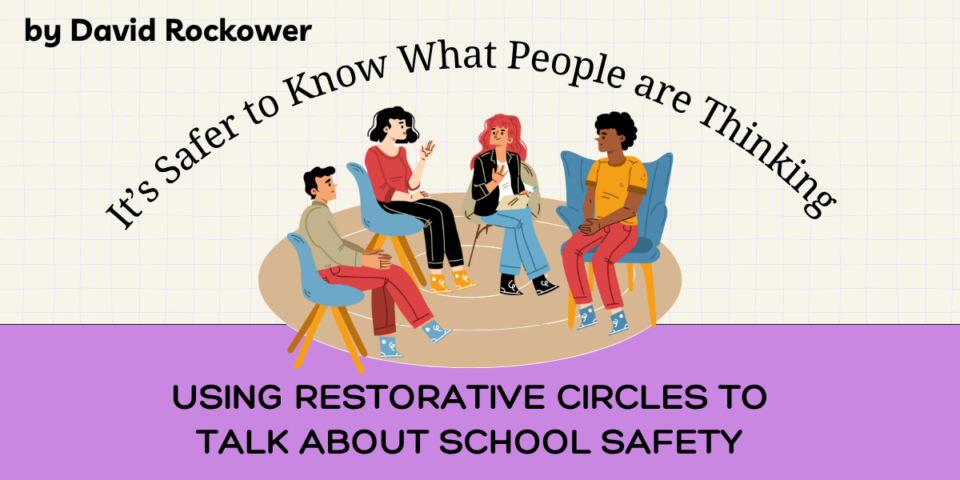
by David Rockower. David is the author of The Power of Teaching Vulnerably.
I teach at Delta High School, a small (public) school of choice within our larger school district. Student voice is paramount here, as teens are called upon to facilitate weekly all-school meetings and participate in advisory council (the school’s governing body) alongside teachers and parents. Classes are mixed-grade-level, and students and staff are on a first name basis. Semester-long classes break the traditional mold—instead of English 9, students might enroll in Human Rights, Art of the Personal Essay, or American History through Music. Student voice is embedded in the school’s DNA, and everyone in our community knows their voice is not only valued—it’s expected.
The Students Demand Action initiative, led by high school and college students, works toward keeping schools and communities safe from gun violence. Their most recent effort was a national walkout on September 5, 2025. We had an all-school meeting planned for September 5—the topic of discussion unrelated to the national walkout. When our advisory council learned of the walkout, they suggested we alter our plans and hold restorative circles for students and staff to share their thoughts about school safety. Two of our teachers run a weekly committee that trains students to facilitate circle conversations. For more information and how to implement circles in your school, check out The International Institute for Restorative Practices. We meet in clumps—our term for homeroom—where 16 students and staff sit in a circle, as each person shares their thoughts. If they have nothing to offer, they may pass. The facilitator reviews the norms and then asks questions.
Questions We Asked
For our September 5 meeting, these were the questions that we discussed:
- What’s been on your mind this week?
- School safety issues have been on the mind of some students in our Delta community. What does ‘school safety’ mean to you?
- Can you describe a time you felt really safe at school? What made you feel that way?
- Optional: Have you ever felt unsafe at school?
- If you could change one thing to make school safer, what would it be?
- What’s one thing you can do to help others feel safe at school?
- What’s one way our clump can support each other throughout the school year?
- Or: What can our clump do to have our voices heard?
- What’s one small step you can take this afternoon to help someone feel supported?
- What’s one word or thought you’re leaving the circle with?
What Students Had to Share
When the circle began, it was clear we wouldn’t get through all of our questions in the allotted time, and that was fine. Most students shared openly, while some chose to pass and listen. One student in each clump took notes so that advisory council could compile the feedback and share it with administrators. When we came to question #3, students spoke about relationships. They emphasized how safe they felt in classrooms where they had a connection to the teacher. “Being part of a small community where everyone knows each other makes it easier to share your thoughts and opinions,” said one student. Another student added, “Because we are invited to discuss issues like this in our school—even though the topics can be frightening—I feel safer.”
When we got to question #5, the answers were surprising. There were a few comments about safety precautions like metal detectors and badge scanners. Some students said they would feel safer with these precautions, while others felt they wouldn’t make a real difference. Most of the comments came back to knowing one another.
They talked about making connections with classmates, checking on community members—especially those who may seem lonely. There was conversation around bringing these topics into the classroom. The circles are helpful, they said, but integrating these important conversations into curriculum establishes a commitment to ongoing safety. When I looked at the notes from the other clumps, it was more of the same. Student comments were vulnerable, authentic, and insightful:
- “If someone is eating lunch alone, see if they want company.”
- “More kindness and respect for others, don’t put them down.”
- “Honest expression—it feels safer to know what people think rather than not knowing.”
- “Pay attention to body language of others.”
- “Remove the stigma around both anxiety and depression.”
Do our students and staff believe that connection and community will stop all violence in schools? No. Did they feel that the security measures were unimportant? Not at all. We should be doing everything we can to avoid future tragedies. However, what came across loud and clear from the students was this: we can build bullet-proof schools, but unless we make our classrooms and schools places where students are seen, heard, and valued, the crux of the problem remains unchanged.
Works Cited
International Institute for Restorative Practices. (2015). Restorative practices: Explained | restorative practices. Www.iirp.edu; International Institute for Restorative Practices. https://www.iirp.edu/restorative-practices/explained
Students Demand Action. (n.d.). Students Demand Action. https://studentsdemandaction.org/
Related Reading

In Chapter 5 of Youth Scribes: Teaching a Love of Writing, R. Joseph Rodríguez discusses "Living Antiracism and Equity." In the following adapted excerpt, he describes a writing assignment where students can question and analyze moments of antiracism.

The following is an adapted excerpt from Rebecca Bellingham and Veronica Scott's The Artful to Exploring Identity and Fostering Belonging. See the book for the figure version of this post.

The following is an adapted excerpt from Teaching Beyond the Timeline by China Harvey and Lisa Herzig.